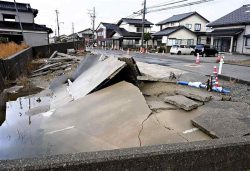10% of Noto Quake Rescue Requests on X Believed Fake; Originator Profile to be Tested as Early as Autumn

A screen capture of Twitter’s official page with an “X” on the profile image is seen on July 23, 2023 in this screengrab obtained from a social media website.
14:54 JST, August 5, 2024
About 10% of rescue requests posted on X, formerly Twitter, following a major earthquake that hit the Noto Peninsula on New Year’s Day are believed to have been fake, according to analysis by the National Institute of Information and Communications Technology.
NICT is a public research institution under the jurisdiction of the Internal Affairs and Communications Ministry.
The fake posts are believed to have been made to gain revenue by achieving a high number of impressions. NICT is calling for efforts to establish means of information sharing whose reliability can be ensured to be expedited.
NICT extracted about 17,000 posts on X written in Japanese within 24 hours of the earthquake. After narrowing them down to 1,091 posts using expressions seeking rescue, such as “help” and “SOS,” with AI-assisted analysis, NICT researchers examined the posts one by one and determined their authenticity by referring to information on actual damage caused by the quake.
The analysis determined 104 posts as being false. It also found that most of them contained an identical message seeking help, although they were posted on different accounts. One post said, “We need help, a child is with us,” and included the name of a nonexistent district in the city of Suzu, Ishikawa Prefecture.
False messages were also posted on foreign accounts. Most of these messages are believed to have been posted to earn impressions and receive more ad revenue.
The Ishikawa prefectural police on July 24 arrested a 25-year-old man from Saitama Prefecture on suspicion of posting fake rescue requests on X following the Noto Peninsula quake. He is accused of pretending to be a disaster victim and claiming that his family was trapped under a collapsed house and needed rescuing.
In this case, an acquaintance of a person who saw the messages contacted the Wajima city office, prompting rescue personnel from the police to search the site based on the information. But they found no collapsed building. The police claim that the posts thus hampered their essential operations.
The Fire and Disaster Management Agency says firefighters are basically not dispatched based on social media posts alone.
“Some people report such information to us without realizing it is fake. If a case requiring rescue has really happened, we are not allowed to neglect it. Those on the front line are forced to make difficult decisions,” said an agency official in charge.
The Originator Profile Collaborative Innovation Partnership is engaged in the development of Originator Profile (OP), a digital technology that identifies the disseminators of information on the internet. It plans to conduct a verification test using the OP technology in a disaster-affected area as early as autumn to see its impact in combating the spread of disinformation.
University of Hyogo Prof. Reo Kimura stressed the need to take steps to address the problem of disinformation on social media.
“The number of fake posts is expected to increase in the future,” the professor said. “The problem of rescue requests is a major one that concerns human life. The central government and other parties concerned need to draw up guidelines on how rescue organizations should deal with social media and reduce the burden on those working on the front line.”
"Society" POPULAR ARTICLE
-

M4.9 Earthquake Hits Tokyo, Neighboring Prefectures
-

Israeli Tourists Refused Accommodation at Hotel in Japan’s Nagano Pref., Prompting Protest by Israeli Embassy and Probe by Prefecture
-

M7.5 Earthquake Hits Northern Japan; Tsunami Waves Observed in Hokkaido, Aomori and Iwate Prefectures
-

Tsukiji Market Urges Tourists to Avoid Visiting in Year-End
-

M5.7 Earthquake Hits Japan’s Kumamoto Pref., Measuring Upper 5 Intensity, No Tsunami Expected
JN ACCESS RANKING
-

Keidanren Chairman Yoshinobu Tsutsui Visits Kashiwazaki-Kariwa Nuclear Power Plant; Inspects New Emergency Safety System
-

Imports of Rare Earths from China Facing Delays, May Be Caused by Deterioration of Japan-China Relations
-

Tokyo Economic Security Forum to Hold Inaugural Meeting Amid Tense Global Environment
-

University of Tokyo Professor Discusses Japanese Economic Security in Interview Ahead of Forum
-

Japan Pulls out of Vietnam Nuclear Project, Complicating Hanoi’s Power Plans
























